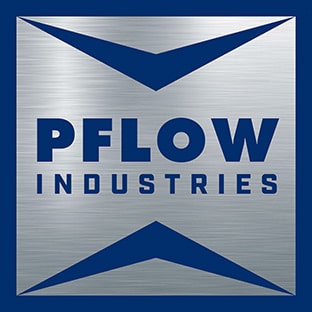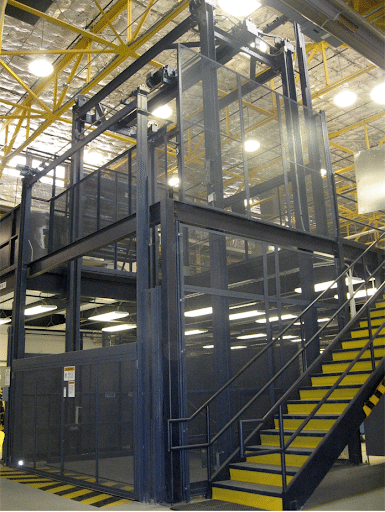As was said by our legendary founder, Bob Pfleger: “Before we could build a business, we had to create an industry.”
In 1981, PFlow Industries transformed the material handling industry by introducing the first vertical reciprocating conveyor (VRC) material lift, replacing our earlier inclined conveyor. This innovation created an entirely new category of material lifts, setting a new standard for the safe and efficient vertical movement of goods.
Before the VRC, companies relied on forklifts or costly, space-consuming freight elevators to move materials between floor levels. While PFlow's inclined conveyor was safer than forklifts, it required a large operational footprint.
PFlow's VRC solved these challenges by offering a material lifting solution that could be purpose-built foreach user's unique material lifting application or space constraints.
Unlike freight elevators, vertical reciprocating conveyors do not move people making them a better choice for moving materials. Read on to explore the advantages of choosing a VRC for optimizing material movement in your facility.
Freight Elevators vs. VRC Lifts
Installing a freight elevator in your facility means meeting the same strict codes, safety redundancies, and ongoing maintenance requirements as passenger elevators. For businesses that only need to move materials—not people—this results in wasted time, unnecessary complexity, and significantly higher ongoing costs.
Key disadvantages of using freight elevators for material handling include:
- Location limitations that can limit facility design flexibility. (Freight elevators require dedicated shaftways and other infrastructure that is not required for VRC lifts.)
- Space requirements that reduce usable floor space.
- Expensive safety redundancies and code requirements (ASME A17.1) designed for ensuring passenger safety, not materials, driving up installation and ongoing maintenance costs.
By contrast, a PFlow VRC lift is purpose built for moving freight. Choosing a VRC instead of a freight elevator can help your business:
- Save money on installation and on-going maintenance and inspection costs. VRCs must meet ASME B20.1 code requirements for conveyors (not people moving elevators).
- Maximize space efficiency in your facility by making the most of your facility's footprint VRCs can be installed virtually anywhere, indoors, outdoors, in an existing elevator shaftway—any place you need to lift goods to another floor level.
- Improve productivity with faster, safer, and more flexible material handling.
Read More: 5 Things You Must Know When Choosing a Freight Lift Elevator
Why Choose a VRC Over a Freight Elevator?
Unlike freight elevators, VRCs are purpose-built for moving materials—not people. This distinction matters because VRCs are officially recognized under their own national code (ASME B20.1) rather than the passenger elevator code (ASME A17.1). In fact, PFlow Industries helped drive this code change, ensuring VRCs are regulated as safe, efficient, material-only lifting equipment.
That exemption means you can realize lower installation costs, have less code-required inspections and maintenance costs, while having greater design flexibility than a freight elevator can offer. VRCs can be installed virtually anywhere—indoors, outdoors, or even in an existing elevator shaft—while accommodating material loads of almost any size, weight, or height.
Additional Benefits of Choosing a VRC
- Placement versatility — they can be installed where elevators cannot
- Seamless integration with automated conveyor systems
- High-speed, high-capacity options for demanding applications
- Multiple standard and optional safety features
- Flexible load / unload patterns
- Lower overall cost of ownership compared to a freight elevator
From pallet handling and package movement to machinery transfer and automated systems integration, PFlow VRCs are built to handle it all.
Talk with a VRC expert today to discover how a PFlow VRC solution can transform your material lifting operations.

